
The types of fuels formed from SOD-killed trees are related to how fast the tree has died, whether failures occurred before or after tree death, and the length of time since tree death (see also figure 2-2A and figure 2-2B, and 2.2.3.2. SOD-related mortality and fire). Table 3-5 shows examples of dead fuels that may accumulate in coast live oak stands affected by SOD. The left two columns show aerial fuels associated with standing SOD-killed trees. The right two columns demonstrate how fuels degrade over time when they are on the ground. Stages of degradation for trees that are dead and defoliated before failure are about 1 to 2 years advanced compared with green failures, but are similar if the date of tree death is used as the starting time reference point. Icons to the left of each photo illustrating tree condition are the same as used in figure 2-2.
Note that all standing dead trees have an elevated risk of failure and in particular, can pose a hazard to firefighting personnel.
Table 3-5—Definitions of aerial fuels that develop over time in standing dead coast live oaks killed by SOD
Factor |
Level |
icon |
Photo |
Fuel stage |
Dead1. Standing dead with leaves |
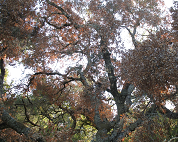 |
|
Time period |
1-2 years after tree death |
||
Primary fuel type(s) |
Aerial |
||
Fire effects |
Canopy readily ignited, will serve as source of embers |
||
Fuel stage |
Dead2. Standing dead without leaves, with fine branches |
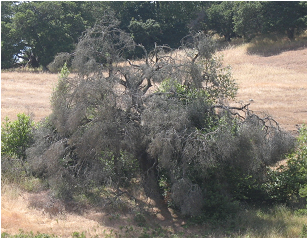 |
|
Time period |
2-3+ years after tree death |
||
| Primary fuel type(s) | Aerial |
||
Fire effects |
Canopy may ignite if sufficiently low and dense. Failure risk is high. |
||
Fuel stage |
Dead3. Standing dead with branch failures, some fine branches present |
 |
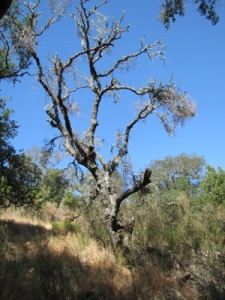 |
Time period |
2-4+ years after tree death |
||
Primary fuel type(s) |
Surface, aerial |
||
Fire effects |
Piles of failed branches (fuel stage B2 to B3) increase depth of ground fuel layer, can form fuel ladders to connect ground and aerial fuels. Aerial fuels may be too sparse to ignite readily but are highly prone to failure. |
||
Fuel stage |
Dead4. Snag, large diameter stems failed |
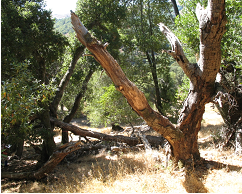 |
|
Time period |
4-6+ years after tree death |
||
Primary fuel type(s) |
Surface |
||
Fire effects |
Large standing stems do not easily ignite, but are prone to fail. Debris piles are fuel stage B3 to B4, dominated by large diameter branches that may be mostly decayed. Fine fuels are decayed and in or near duff layer |
Table 3-6—Definitions of ground fuels that develop over time in failed coast live oaks killed by SOD
Factor |
Level |
Photo and icon |
|
Fuel stage |
Failed1. Failed tree or branch with leaves |
|
|
Time period |
1-2 years after tree death or green failure |
||
Primary fuel type(s) |
Surface |
||
Fire effects |
Very readily ignited, can serve as fuel ladder to carry surface fire to canopy |
||
Fuel stage |
Failed2. Large diameter stems, fine branches, few to no leaves |
|
|
Time period |
2-4 years after tree death or green failure |
||
| Primary fuel type(s) | Surface |
||
Fire effects |
Readily ignited, can serve as ground to canopy fuel ladder |
||
Fuel stage |
Failed3. Primarily large diameter branches, fine fuels mostly rotted and in or near duff layer |
|
|
Time period |
3-8+ years after tree death or green failure |
||
Primary fuel type(s) |
Surface |
||
Fire effects |
Increases total ground fuels, but debris piles are generally low, typically no more than 1 m tall |
||
Fuel stage |
Failed4. Decayed large diameter stems, all small branches decayed |
 |
|
Time period |
6-10+ years after tree death or green failure |
||
Primary fuel type(s) |
Surface |
||
Fire effects |
Minimal contribution to ground fuels |
Table 3-7—Time sequences of degradation of aerial and ground fuels in three coast live oaks killed by SOD
Icon |
Photo and description |
|
|
|
|
|
|
|
|
|
|
|
|
|
|
|
|
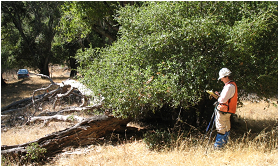 Eight years after failure. Fuel stage still Failed3. (Marin Co.) Eight years after failure. Fuel stage still Failed3. (Marin Co.) |